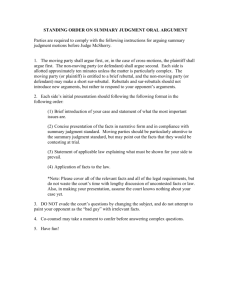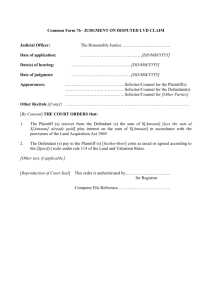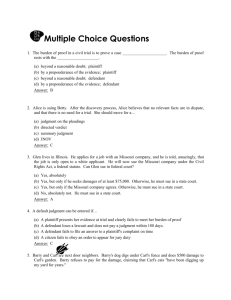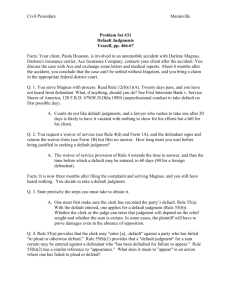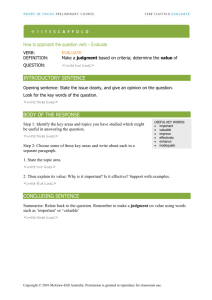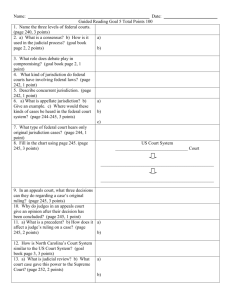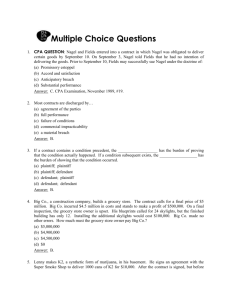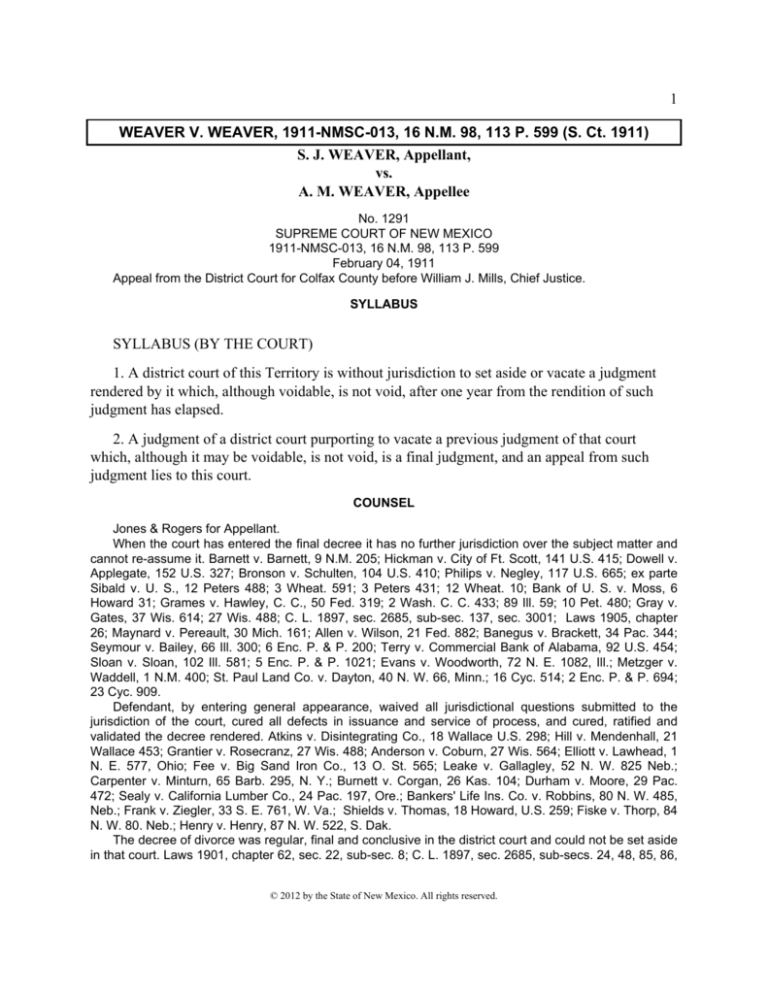
1
WEAVER V. WEAVER, 1911-NMSC-013, 16 N.M. 98, 113 P. 599 (S. Ct. 1911)
S. J. WEAVER, Appellant,
vs.
A. M. WEAVER, Appellee
No. 1291
SUPREME COURT OF NEW MEXICO
1911-NMSC-013, 16 N.M. 98, 113 P. 599
February 04, 1911
Appeal from the District Court for Colfax County before William J. Mills, Chief Justice.
SYLLABUS
SYLLABUS (BY THE COURT)
1. A district court of this Territory is without jurisdiction to set aside or vacate a judgment
rendered by it which, although voidable, is not void, after one year from the rendition of such
judgment has elapsed.
2. A judgment of a district court purporting to vacate a previous judgment of that court
which, although it may be voidable, is not void, is a final judgment, and an appeal from such
judgment lies to this court.
COUNSEL
Jones & Rogers for Appellant.
When the court has entered the final decree it has no further jurisdiction over the subject matter and
cannot re-assume it. Barnett v. Barnett, 9 N.M. 205; Hickman v. City of Ft. Scott, 141 U.S. 415; Dowell v.
Applegate, 152 U.S. 327; Bronson v. Schulten, 104 U.S. 410; Philips v. Negley, 117 U.S. 665; ex parte
Sibald v. U. S., 12 Peters 488; 3 Wheat. 591; 3 Peters 431; 12 Wheat. 10; Bank of U. S. v. Moss, 6
Howard 31; Grames v. Hawley, C. C., 50 Fed. 319; 2 Wash. C. C. 433; 89 Ill. 59; 10 Pet. 480; Gray v.
Gates, 37 Wis. 614; 27 Wis. 488; C. L. 1897, sec. 2685, sub-sec. 137, sec. 3001; Laws 1905, chapter
26; Maynard v. Pereault, 30 Mich. 161; Allen v. Wilson, 21 Fed. 882; Banegus v. Brackett, 34 Pac. 344;
Seymour v. Bailey, 66 Ill. 300; 6 Enc. P. & P. 200; Terry v. Commercial Bank of Alabama, 92 U.S. 454;
Sloan v. Sloan, 102 Ill. 581; 5 Enc. P. & P. 1021; Evans v. Woodworth, 72 N. E. 1082, Ill.; Metzger v.
Waddell, 1 N.M. 400; St. Paul Land Co. v. Dayton, 40 N. W. 66, Minn.; 16 Cyc. 514; 2 Enc. P. & P. 694;
23 Cyc. 909.
Defendant, by entering general appearance, waived all jurisdictional questions submitted to the
jurisdiction of the court, cured all defects in issuance and service of process, and cured, ratified and
validated the decree rendered. Atkins v. Disintegrating Co., 18 Wallace U.S. 298; Hill v. Mendenhall, 21
Wallace 453; Grantier v. Rosecranz, 27 Wis. 488; Anderson v. Coburn, 27 Wis. 564; Elliott v. Lawhead, 1
N. E. 577, Ohio; Fee v. Big Sand Iron Co., 13 O. St. 565; Leake v. Gallagley, 52 N. W. 825 Neb.;
Carpenter v. Minturn, 65 Barb. 295, N. Y.; Burnett v. Corgan, 26 Kas. 104; Durham v. Moore, 29 Pac.
472; Sealy v. California Lumber Co., 24 Pac. 197, Ore.; Bankers' Life Ins. Co. v. Robbins, 80 N. W. 485,
Neb.; Frank v. Ziegler, 33 S. E. 761, W. Va.; Shields v. Thomas, 18 Howard, U.S. 259; Fiske v. Thorp, 84
N. W. 80. Neb.; Henry v. Henry, 87 N. W. 522, S. Dak.
The decree of divorce was regular, final and conclusive in the district court and could not be set aside
in that court. Laws 1901, chapter 62, sec. 22, sub-sec. 8; C. L. 1897, sec. 2685, sub-secs. 24, 48, 85, 86,
© 2012 by the State of New Mexico. All rights reserved.
94; Denning v. Denning, 99 S. W. 1029; Sylvis v. Sylvis, 17 Pac. 912; Blondeau v. Snyder, 31 Pac. 591,
Oreg.; Canadian etc. Co. v. Clarita L. & I. Co., 74 Pac. 301; Frankfurth v. Anderson, 20 N. W. 662;
Voorhees v. Bank of U. S., 10 Pet. 449; U. S. v. Arrendo, 6 Pet. 729; Hop Bitters Co. v. Warner, 28 Fed.
577; Griswold v. Hazzard, 141 U.S. 260; 5 Enc. P. & P. 1016; Mayer v. Wilson, 76 N. E. 748, Ind.; Brown
& Manzanares Co. v. Gise, 14 N.M. 282; 7 Enc. P. & P. 138; Bascom v. Bascom, 7 O. 125; Bingham v.
Miller, 17 O. 445; Lewis v. Lewis, 15 Kas. 144; Lucas v. Lucas, 69 Mass. 136; Edson v. Edson, 108
Mass. 590; O'Connell v. O'Connell, 6 N. W. 467, Neb.; Parish v. Parish, 9 Ohio St. 534; Singer v. Singer,
41 Barbour, N. Y. 139.
The order was a final decision and reviewable. The People v. Ferris, 33 N. Y. 220; Hume v. Bowie,
148 U.S. 246; Philips v. Negley, 117 U.S. 665; 2 Enc. P. & P. 109; Octgen v. Ross, 36 Ill. 335; Guthrie v.
Guthrie, 30 N. W., Ia. 779; Spencer v. Thistle, 13 N. W., Neb. 214; William Deering Co. v. Creighton, 38
Pac., Or. 710; Post v. Wallace, 20 Atl., Pa. 409; Mich. Ins. Co. v. Whittemore, 12 Mich. 311; Laws 1905,
chap. 26; C. L. 1897, sec. 2875; Terry v. Commercial Bank of Alabama, 92 U.S. 454; Bronson v.
Schulten, 104 U.S. 415; Philips v. Negley, 117 U.S. 665; Bank v. Hawley, 50 Fed 319; Maynard v.
Perault, 30 Mich. 161; Allen v. Wilson, 21 Fed. 882; Barnett v. Barnett, 9 N.M. 205; 18 Enc. P. & P. 1012;
Gray v. Moore, 7 Gray 215; 9 Enc. P. & P. 684; 7 Enc. P. & P. 145; Gray v. Earl, 13 Iowa 188; Knox v.
Smith, 4 Howard 298; Noonan v. Lee, 2 Black, U.S. 499; Voorhees v. Bonesteel, 16 Wallace 16; Very v.
Levy, 13 Howard 345; Patton v. Taylor, 7 Howard 132.
S. B. Davis for Appellee.
The district court had no jurisdiction to render the decree. C. L. 1897, sec. 1433; Tyler v. Murray, 57
Md. 418; Morton v. Morton, Colo., 27 Pac. 718; Yorke v. Yorke, 55 Mo. 1095; Laws 1901, chap. 62, sec.
22.
Action setting aside decree was correct. C. L. 1897, secs. 2875, 2685, sub-sec. 137, sec. 3001;
Phillips v. Negley, 117 U.S. 665; Fowler v. Equitable Trust Co., 141 U.S. 384; Stocklager v. U. S., 116
Fed. 590; Laws 1901, chap. 11, sec. 2; McBlain v. McBlain, 77 Cal. 507; Simensen v. Simensen, N. D.,
100 N. W. 708; Robertson v. Robertson, 9 Daly 44; Jewitt v. Jewitt, 2 N. Y. Supp. 250; Weatherbee v.
Weatherbee, 20 Wis. 499.
Courts of Equity have inherent power to set aside and vacate judgments or decrees obtained through
fraud or rendered without jurisdiction. Black on Judgments, par. 321; Dial v. Farrow, 36 Am. Dec. 267;
Edson v. Edson, 108 Mass. 590; Johnson v. Coleman, 23 Wis. 452; Crouch v. Crouch, 30 Wis. 667;
Holmes v. Holmes, 63 Me. 420; Adams v. Adams, 51 N. H. 388; Rawlins v. Rawlins, 18 Fla. 345; True v.
True, 6 Minn. 458; Young v. Young, 17 Minn. 181; Allen v. McClellan, 12 Pa. 328; Boyd's Appeal, 38 Pa.
St. 241; Whitcomb v. Whitcomb, 46 Ia. 437; Everett v. Everett, 18 N. W. 637; Cross v. Gould, 110 S. W.
672.
By entering general appearance the defendant did not waive all jurisdictional questions, cure all
defects in the issuance and service of process, and ratify and validate the decree. The only effect of such
an appearance was to give the district court jurisdiction of the person of the defendant from the date of
the motion. Simensen v. Simensen, N. D., 100 N. W. 708; Yorke v. Yorke, 55 Mo. 1095.
The question of public policy goes not to the power of the lower court to set aside the decree but to
the manner of the exercise of that power. Crouch v. Crouch, 30 Wis. 667; Whitcomb v. Whitcomb, 46 Ia.
437; Yorke v. Yorke, 55 Mo. 1095.
Supreme Court of Territory has jurisdiction to review proceedings in district courts. Act. Sept. 9, 1850,
sec. 10; Laws 1907, chap. 57; Jung v. Myer, 11 N.M. 378; Cutter & Neilson Co. v. Hinman, et al, 14 N.M.
62; DeHarrison v. Perea, 11 N.M. 505; Machen v. Keeler, 11 N.M. 413; Board of County Commissioners
v. Blackington, 11 N.M. 360.
A decree to be final for the purposes of an appeal must terminate the litigation between the parties on
the merits of the case. Lodge v. Tirell, 135 U.S. 232; M. K. & P. Ry. Co. v. Dinsmore, 108 U.S. 30;
Bostwick v. Brinkerhoff, 106 U.S. 3; in re Norton, 108 U.S. 237; Winthrop Iron Co. v. Meeker, 109 U.S.
180; St. Louis I. M. & S. Co. v. So. Exp. Co., 108 U.S. 24; Grant v. Phoenix Mutual Life Ins. Co., 106 U.S.
429; Bent v. Miranda, 8 N.M. 78; Huntington v. Moore, 1 N.M. 471; Bucher v. Thompson, 7 N.M. 599;
Territory v. Las Vegas Grant, 6 N.M. 87; Jung v. Myer, 11 N.M. 378; Hume v. Bowie, 148 U.S. 245; Wade
v. McLeyer, 63 N. Y. 318; Miller v. Tyler, 58 N. Y. 477; Davis v. Borst, 58 N. Y. 669; Higgins v. Brown, 5
Colo. 345; Owen v. Going, 7 Colo. 85; Felt v. Cook, 87 Pac. 1092; Everett v. Jones, 91 Pac. 360; Rauer's
Law & Collection Co. v. Stanley, 84 Pac. 214; Sengfelder v. Powell-Sanders Co., 82 Pac. 931; Connor v.
Peugh, 18 How. 394; Philips v. Negley, 117 U.S. 665; Staab v. A. & P. R. R. Co., 3 N.M. 606.
Courts of equity have inherent powers to set aside and vacate judgments or decrees obtained
through fraud or rendered without jurisdiction. 1 Black on Judgments, par. 321; Dial v. Farrow, 36 Am.
Dec. 267; Edson v. Edson, 108 Mass. 590; Johnson v. Clemens, 23 Wis. 452, Crouch v. Crouch, 30 Wis.
667; Holmes v. Holmes, 63 Me. 420; Adams v. Adams, 51 N. H. 388; Rawlins v. Rawlins, 18 Fla. 345;
True v. True, 6 Minn. 458; Young v. Young, 17 Minn. 181; Allen v. McClellan, Pa. 328; Boyd's Appeal, 38
Pa. St. 241; Whitcomb v. Whitcomb, 46 Ia. 437; Everett v. Everett, 18 N. W. 637; C. L. 1897, sec. 2875;
Nelson v. Meehan, 155 Fed. 1; Fowler v. Equitable Trust Co., 141 U.S. 384; Stocklager v. U. S., 116
Fed. 590.
JUDGES
Abbott, J.
AUTHOR: ABBOTT
OPINION
{*102} STATEMENT OF THE CASE.
{1} This case is here on appeal from an order of the District Court of the Fourth District, for
Colfax County, setting aside a decree of divorce theretofore granted by that court on the
complaint of S. J. Weaver against A. M. Weaver, filed July 26, 1905. Notice of the pendency of
the cause was published by order of the court, and, on September 23, 1905, the defendant, here
the appellee, was defaulted, and the case sent to a referee to take proofs. On the report of the
referee a final decree was rendered October 21, 1905, granting to the plaintiff, here the appellant,
a divorce from the defendant. On October 8, 1908, the defendant filed a motion to vacate and set
aside the judgment on the grounds that it appeared of record in the case that the affidavit on
which the order of publication {*103} was made, was not such as to warrant the order, and that
no one of the statutory grounds of divorce was alleged in the complaint, for which reason, she
alleged, the court never had jurisdiction to render the judgment. "For further grounds not
apparent on the face of said record, the defendant shows to the court," in substance, that no
service upon her had been made, that she did not know of the cause until December 30, 1906,
when she received a letter from the clerk of the court notifying her of the decree; that she was,
during all the time in question, a resident of Rochester, New York, where she and the plaintiff
had lived as husband and wife, and where he, as she alleges, deserted her in the year 1900. And,
while fraud is not charged in set terms, it is fairly to be inferred from the statements of fact that
the defendant claimed the plaintiff used fraudulent means to prevent her from learning of the
pendency of the cause. "And the defendant further shows to the court that she has a good defense
to the above entitled cause on the merits; that she never deserted or abandoned the plaintiff, but,
on the contrary, the plaintiff deserted her . . . . That she was never guilty of any cruel or inhuman
treatment of plaintiff, and that this defendant never was finally convicted of any felony and never
was imprisoned therefor in any penitentiary . . . . Wherefore defendant asks that the judgment
rendered in the above entitled cause may be vacated and set aside, and that she be allowed to file
her answer therein." To this plaintiff demurred. No separate action appears to have been taken on
the demurrer; but on January 27, 1909, the court made an order vacating its decree, allowing the
plaintiff thirty days in which to amend his complaint, and to the defendant twenty days after the
expiration of that time, in case an amended complaint should not be filed within it, to plead to
the original complaint. February 3, 1909, the plaintiff moved the court to vacate the order setting
aside the decree of divorce, which motion was denied February 10, 1909. The plaintiff did not
amend his complaint as permitted by the order of January 27, 1909, and on March 10, 1909, the
defendant filed a demurrer to the original complaint, which is still pending {*104} in the district
court. April 17, 1909, the plaintiff appealed to this court from the order vacating the original
decree. The defendant moved to dismiss the appeal on the ground that it was not an appeal from
a final judgment. On the grounds stated in Weaver v. Weaver, 15 N.M. 333, 107 P. 527, this
court declined to render a decision on the motion to dismiss the appeal until after hearing on the
merits, which has since taken place.
OPINION OF THE COURT.
{2} We have first to decide whether this cause is properly here on appeal, and, if we consider
that it is, then, whether the action of the District Court in vacating the decree of divorce shall be
approved. Although it is claimed, in the brief for the appellee, that the judgment of the District
Court granting a divorce was void, the defendant has, apparently, treated it as voidable rather
than void, since in her motion to have it set aside she has gone beyond the averments necessary
to sustain it and set out matter which, she says, would constitute a defense on the merits, and
asked to be allowed to answer after the vacation of the judgment. By that she submitted her
person to the jurisdiction of the court, and, while we are not prepared to hold, as counsel for the
appellant contend, that she thereby "cured, ratified and validated the decree" which she was
asking to have set aside, we think she might fairly be held to have precluded herself from
claiming that it is void for want of jurisdiction of her person, and, indeed, to have consented that
the court have jurisdiction of the cause. B. Colo. Sanatorium v. Van Stone, 14 N.M. 436, 94 P.
945; Atkins v. Disintregating Co., 85 U.S. 272, 18 Wall. 272, 298, 21 L. Ed. 841; Hill v.
Mendenhall, 88 U.S. 453, 21 Wall. 453, 22 L. Ed. 616; Grantier v. Rosecrance, 27 Wis. 488;
Burdette v. Corgan, 26 Kan. 102; Shields v. Thomas, 59 U.S. 253, 18 HOW 253, 259, 15 L. Ed.
368; Henry v. Henry, 15 S.D. 80, 87 N.W. 522 (S. Dak.) But, independent of that, we are of the
opinion that there is nothing apparent of record to show that the judgment was void. That the
court had jurisdiction of the subject matter is not questioned. It was a court of general
jurisdiction, with power to grant divorces to persons who had {*105} been residents of the
Territory for a year next before instituting proceedings for divorce. "The residence of plaintiff,
and not that of defendant, gives jurisdiction in divorce cases, although service of process is
constructive." 14 Cyc. 588. See, also, 17 Cent. Dig. Title Divorce; secs. 1431-3, C. L. 1897.
{3} It could obtain jurisdiction of the person of a non-resident defendant for the purpose of
granting a divorce through publication of notice based on an affidavit as prescribed by law. The
affidavit filed in this cause conforms to the requirements of the statute on the subject, in
substance, so far as the record shows. The defendant objects to it that it did not state the street
address in Rochester, New York, of the defendant, and did not state that any means had been
taken to ascertain it. But the statute does not require that excuses shall be made unless there is a
failure to state the residence of the defendant, and the residence was given as Rochester, New
York, which made the affidavit complete in form in that particular. It is also objected that the
affidavit could not properly be made by the plaintiff's attorney merely for the reason that the
plaintiff was not in the county. But the statute allows that. Laws 1901, ch. 62, sec. 22, sub-sec. 8;
C. L. 1897, sec. 2685, sub-sec. 48. In addition, an order was made by the court directing
publication. That the affidavit was carelessly drawn and should have been more explicit, and that
the same is true of the complaint, need not be denied, although the defendant seems to have had
no difficulty in understanding the allegations of the complaint well enough to deny each of them
specifically in her motion to vacate the judgment. But it is not until we get information from
outside of the record that we have any ground for believing that the judgment was voidable and
might have been properly vacated on a motion seasonably made. The essential distinction
between void judgments and those merely voidable must not be disregarded. "In any case where
the court has jurisdiction of the subject matter of the action, and the parties are before it by due
service of proper process, the jurisdiction is never ousted by the erroneous exercise of the power
which it confers, {*106} and the judgment in the case, though it may be marked by error which
will cause its reversal by a higher court, is not for that reason void." Black on Judgments, (2nd
ed.) secs. 170, 244. For ordinary cases, at least, the time within which a judgment can be
vacated, is limited. If the court rendering a judgment has terms, its control of the judgment is
usually limited to the term in which it was rendered. Bronson v. Schulten, 104 U.S. 410, 26 L.
Ed. 797; Grames v. Hawley, 4 McCrary's Cir. Ct. Rpts 61, 50 F. 319. But in this jurisdiction, in
view of the provisions of sec. 2875, C. L. 1897, that the district courts in several counties "shall
be at all times in session," for the numerous purposes named in the statute, it can hardly be said
that there are terms of court, except for purposes connected with jury trials. Territory v. Armijo,
14 N.M. 202, 210, 89 P. 275. That condition may, possibly, have the effect of limiting the literal
meaning of Chap. 26, Laws of 1905, fixing a limit of sixty days for setting aside a judgment
rendered on default "out of term time." But C. L. 1897, sec. 2685, sub-sec. 137, plainly applies to
all judgments, and provides that they may be set aside for irregularity at any time within one year
after rendition. In this case that limit had long been passed when the district court made the order
to vacate the judgment. We do not wish to be understood to hold that a judgment which is
absolutely void can not in any case be declared void by the court which rendered it, after one
year from the time of its rendition; but, as we have said, the judgment now in question was not
void, but at most only voidable at the time the order to vacate was made. That being the case, the
judgment was final. The authority of Phillips v. Negley, 117 U.S. 665, 29 L. Ed. 1013, 6 S. Ct.
901, fully applies. The District Court was without jurisdiction to vacate the decree, and the
appeal from its action is properly here under the provisions of the Organic Act, p. 43, C. L 1897,
and ch. 57, Laws of 1907, and should be sustained. The motion to dismiss the appeal is denied,
and the judgment of the District Court vacating its former judgment is reversed.
——————————

